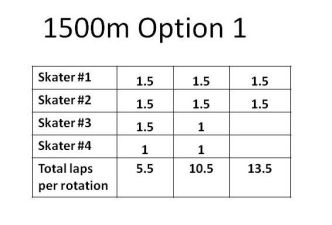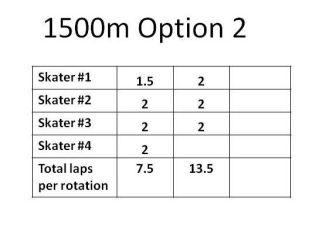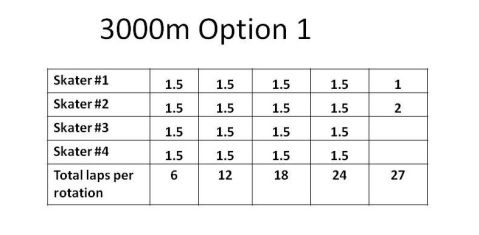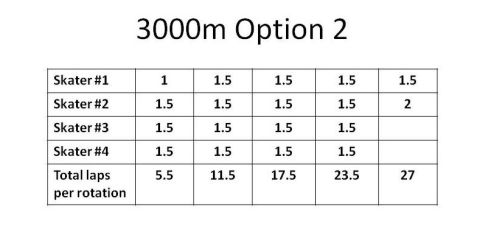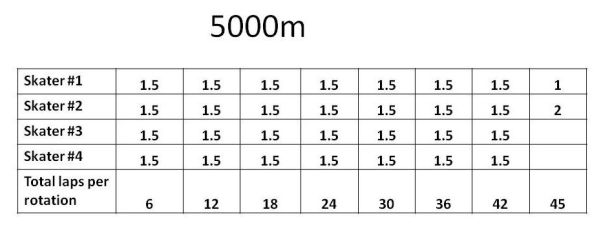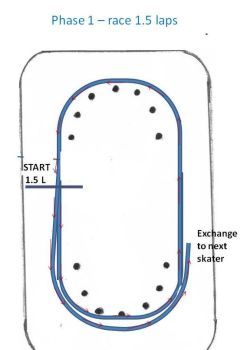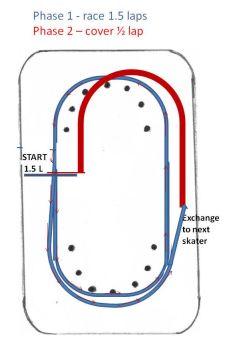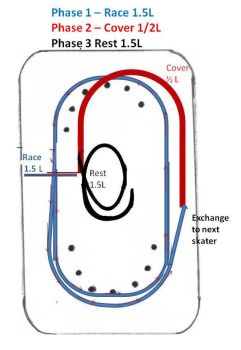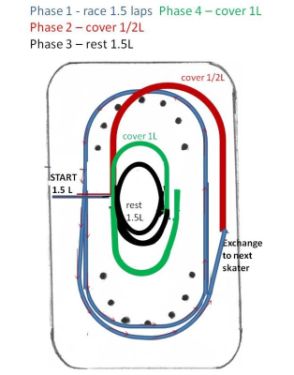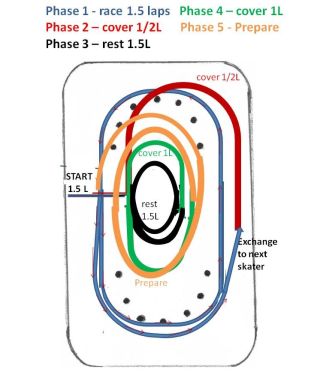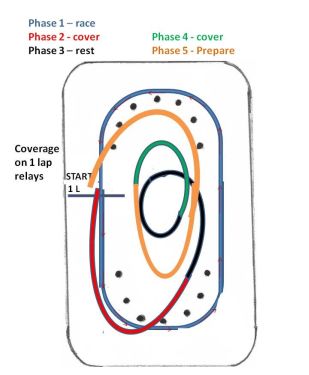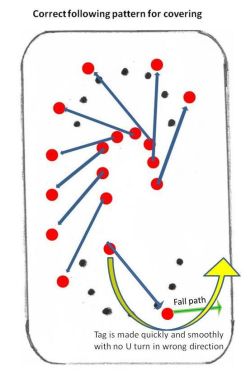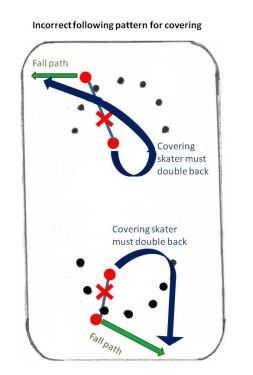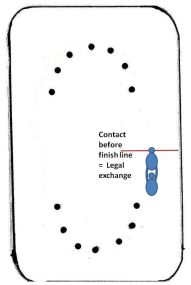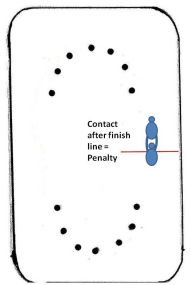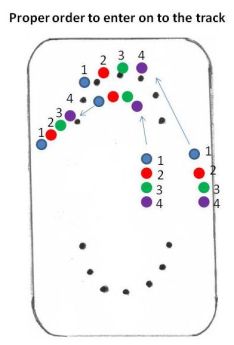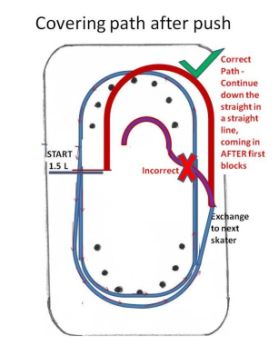Relay Racing – Part 1 – Skater Roles and LapsBy Susan Ellis, January 2011
|
It's not the size of the dog in the fight, but the size of the fight in the dog. ~ Archie Griffin, two-time Heisman winner (5'9) |
Relay races are very important medal races at all major competitions and even some local competitions. They are a great way to end a competition and are also fun and exciting to do. Learning how to do a relay properly is important so you perform your best for yourself and your team. It takes a lot of focus to be in the right place, at the right time, to come out on to the track with good speed, and give the best relay push you can give to propel your teammate.
Each skater has a very important role in the relay whether they are the skater on track, resting, covering, or preparing to come out and you must understand exactly what to do and when to do it.
First you must remember the order of your relay and how many laps you are doing at each stage of the race. Some relays use a one lap rotation per skater, some use 1.5 laps, some use 2 laps. Sometimes the faster or fitter skaters are assigned more laps than slower or not so fit skaters. Here are some typical examples of how relay rotations are organized:
Each skater has a very important role in the relay whether they are the skater on track, resting, covering, or preparing to come out and you must understand exactly what to do and when to do it.
First you must remember the order of your relay and how many laps you are doing at each stage of the race. Some relays use a one lap rotation per skater, some use 1.5 laps, some use 2 laps. Sometimes the faster or fitter skaters are assigned more laps than slower or not so fit skaters. Here are some typical examples of how relay rotations are organized:
In shorter relays like the 1500, it is advantageous to have your fastest starter start the race. Being in the lead in such a short race eliminates dealing with traffic and passing as well as sets up smoother exchanges. Typically the fastest person finishes the relay. In shorter relays like the 1500, if the fastest starter and the fastest skater are the same person your team has a decision to make on which strategy you use – sacrifice the start and hope your fastest skater can pass in to the lead and have the fastest skater out there for the last two laps, or try to win the start and hang on to the lead finishing with your second fastest skater and be prepared to use good blocking tactics.
In longer relays the start is not as important. Teams will generally put the strongest finisher last which normally means starting in position 2, the next fastest and fittest starts in position 1, the weakest skater typically goes 3rd, and the third strongest goes 4th.
There are typically 5 phases to a relay –
Phase 1 – race
Phase 2 – cover the skater you just pushed
Phase 3 – rest, but you still have to pay attention as you are a secondary cover here
Phase 4 – cover again
Phase 5 – prepare to come out on to the track
The following diagrams show a commonly used sequence of each of the phases for a relay using 1.5 lap rotations.
In longer relays the start is not as important. Teams will generally put the strongest finisher last which normally means starting in position 2, the next fastest and fittest starts in position 1, the weakest skater typically goes 3rd, and the third strongest goes 4th.
There are typically 5 phases to a relay –
Phase 1 – race
Phase 2 – cover the skater you just pushed
Phase 3 – rest, but you still have to pay attention as you are a secondary cover here
Phase 4 – cover again
Phase 5 – prepare to come out on to the track
The following diagrams show a commonly used sequence of each of the phases for a relay using 1.5 lap rotations.
|
So, if you are skater #1 and all are doing 1.5 lap exchanges, your job would be: Race 1.5 laps, then push skater #2, then cover skater #2 through the first turn, then rest for 1.5L but still keep an eye on the racing skater as you are the secondary cover for that skater, then you become the primary cover for skater #3 for 1 lap, then you prepare to come on to the track again. Some teams will have the skater go through the whole first turn on the outside of the blocks in Phase 2 rather than coming inside ½ way through as it is easier on the legs at high speed. |
|
The diagram to the right depicts the sequence of phases for a 1 lap exchange relay:
Race 1L, cover 1/2L, rest 1 lap, cover 1/2L, prepare 1L. The covering system is simple – first cover the skater you just pushed, the next cover is at the other end of the ice and is the skater 2 numbers away from you – 1 covers 3, 2 covers 4, 3 covers 1, 4 covers 2. |
Sequence for 1L relays
|
|
Correct follow path for covering
|
Some teams will opt not to bother covering, choosing to rest completely instead, figuring that if they fall they are too far behind to catch up anyway. This has the advantage of being more rested, but if another team falls you may have just lost your chance at a medal by taking a long time to tag the fallen skater. If your team does choose to use a covering system make sure you cover from behind so you have a direct line to the skater without having to make a U turn. |
Incorrect follow path for covering
|
The racing rules for the relay are the same as for any other race in terms of impeding, off track, false starts, etc. Some other rules that apply are:
- All 4 skaters must take part in the relay (ISU rule; your country may have a different rule). This means that even if a skater takes just a couple of steps off the line before tagging another skater they are deemed to have taken part. This scenario sometimes happens when a skater is injured and unable to skate a full lap. Be careful with this one though as you may risk further injury to the skater and also put other skaters at risk.
|
- There must be physical contact for a relay tag to be legal. Sometimes after a skater falls the tagger will miss the tag by mere inches and the team is disqualified. Make sure the tag happens or your team will receive a penalty!
|
So, there you have the basics of the relay. Next month we’ll look more closely at how the exchange takes place, the timing of it, speed of the exchange, the push itself, and more on strategy and tactics of the relay.

